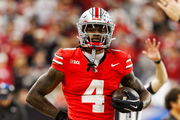

Bethpage Black has hosted majors before, but nothing like this. For the 2025 Ryder Cup, 250,000 fans will pour through the gates in just three days. That’s nearly twice the crowd Yankee Stadium can hold, packed into Bethpage Black every single day. Tickets started at $750, nearly $500 more than in Rome in 2023, and still sold out in a frenzy. Which means the real contest this fall isn’t only U.S. vs. Europe — it’s whether organizers can choreograph one of sport’s most complex logistical feats without a single hitch.
Watch What’s Trending Now!
If planning to make the most of Ryder Cup Friday, set the alarm early. Indeed, security lines and bag checks will eat into your time long before you hear the first tee shot at Bethpage Black. Sure, Bethpage Black isn’t new to big stages; it has hosted two U.S. Opens and a PGA Championship, but this time the scale is off the charts. We’re talking 250,000 fans flooding the grounds over the week. That’s about 50,000 (plus practice days) every single day for three days.
Of course, getting inside this carnival didn’t come cheap. Nearly a year out, news dropped that tickets for competition days would start at $750, almost $500 more than in Rome in 2023. But instead of deterring people, it lit a frenzy. So picture it: 250,000 fans, one of golf’s toughest tracks, and the sport’s fiercest rivalry colliding in New York. So how do you pull off managing this madness without losing your mind? Spoiler: it’s about precision, sweat, and a dash of magic.
ADVERTISEMENT
The mobility machine
Given the scale, driving directly to Bethpage Black is highly restricted; therefore, no parking is allowed at the course or nearby Farmingdale station to avoid congestion. Instead, Enterprise Mobility, the official Ryder Cup transport partner through 2027, takes the wheel. Their fleet runs everything:
Shuttle buses are linked to local transit.
VIP rentals and staff transport.
Managing daily surges of fans and workers to keep everything running like clockwork.
ADVERTISEMENT
For spectators, the Long Island Rail Road is the go-to route. Extra trains with a special $175 event ticket move as many as 18,000 passengers daily, while shuttles from Farmingdale drop fans at the course entrance in about 15 minutes. In addition, to reduce traffic further on local roads, remote park-and-ride hubs at other LIRR stations and Jones Beach offer shuttle service directly to the course.
Top Stories
Jon Rahm Breaks Silence on Enduring ‘Overweight’ Jibes from American Fans: ‘It Was Rough’

Jeremiah Smith Wants to Blame OSU Unit for CFP Loss & Has Urban Meyer’s Backing

Lamar Jackson Bids Goodbye to Ravens’ Underwhelming Season After John Harbaugh’s Firing

Alex Pereira Confirms Major Tracy Cortez Relationship Status Update After Viral Marriage Proposal Clip

PGA Tour Quietly Alters One of Its Most Controversial Rules before 2026 season

Bryson DeChambeau Releases Fresh Statement on His LIV Golf Future Post Brooks Koepka’s Exit

It’s more than logistics; it’s a choreography:
ADVERTISEMENT
Nearly 140,000 hybrid and electric vehicles are in use globally.
Eco-friendly practices cut emissions and keep the Ryder Cup green.
The payoff? Shorter lines, lighter traffic, and a smooth arrival that lets golf be the main event, not the commute. And where there’s choreography, there has to be security to keep the show running.
ADVERTISEMENT
Security that lets the crowds roar
Bethpage Black has been gearing up for years. Over 1.5M square feet of tents now dot the grounds: from VIP hospitality villages and fan merchandise shops to media hubs. Yet, with huge crowds and high-profile guests like President Trump, safety planning was crucial. That’s why Motorola Solutions, appointed Official Safety Technology Supplier through 2027, provides a connected safety net that keeps communication instant and response fast across this sprawling course.
The tools they’re using:
Two-Way Radios (MOTOTRBO R7): Loud, clear, and weatherproof.
AI-Powered Video: Spot unusual activity.
Command Center Software: A digital nerve center connecting radio chatter, video feeds, and reports into a live dashboard.
License Plate Recognition: Tracks every vehicle entering the grounds
ADVERTISEMENT
With tens of thousands of people in one place, there’s no room for error. But those green-side chills go deeper because even the smoothest experience depends on hidden layers of tech operating behind the curtain.
How tech runs the Ryder Cup behind the curtain
There’s a lot happening you’ll never see at the 2025 Ryder Cup. Sure, the roars around the first tee feel spontaneous, but behind the scenes, Hewlett Packard Enterprise (HPE) is making the whole operation run. Think of it this way: every smooth moment from scanning a ticket to grabbing merch to watching a broadcast is powered by a web of AI, cloud systems, and smart tech working together.
ADVERTISEMENT
Here’s how it all works:
Connectivity Everywhere: The venue is wired top-to-bottom with 170 CX switches, 650 Wi-Fi 6E access points, and 67 AI-enabled cameras. All that data flows into a live Operational Intelligence Dashboard tracking things like ticket scans, merch sales, weather, golf cart GPS, queues, and security feeds.
Private Cloud AI: Built with NVIDIA, this system keeps sensitive info like tickets and payment data secure
SAP: Unifies fan data into a single profile.
Capgemini: keeps the Ryder Cup’s digital channels, social media, broadcast streams, and apps running without a hiccup
AllowME tech: handles all the mobile scanning, contact-free entry, catering access, and even post-event reports.
So while fans focus on the big putts and the roars, HPE and its partners focus on making sure the Ryder Cup looks effortless. And when every click and ping works perfectly, it unlocks the real magic: a broadcast that takes the roar of Bethpage far beyond Long Island.
ADVERTISEMENT
Global broadcasts that put you on the green
The 2025 Ryder Cup is going out to the world. IMG runs the world feed, delivering 28 hours of live coverage and extra programming like the official tournament film. In the U.S., NBC covers over 100 hours across its networks and Peacock, with drones, bunker cams, and Trackman swing analysis making its debut. Across the pond, Sky Sports streams full coverage with VR/AR visualizations and alternative feeds, while the BBC provides highlights and clips. Down under, Fox Sports and Kayo Sports bring the action to Australian fans.
Behind the scenes tech & infrastructure:
ADVERTISEMENT
High-Capacity Networks: Keep live streams and mobile connections smooth.
Hybrid Cloud Solutions: Distribute broadcasts across TV, apps, and social media.
AI Analytics: Real-time monitoring.
Capgemini Outcome IQ: Offers fans dynamic insights, “what if” scenarios, and richer storytelling.
Of course, that kind of global theatre doesn’t come cheap, so who’s footing the bill for golf’s glitziest stage?
Who pays for the Ryder Cup?
The 2025 Ryder Cup at Bethpage State Park is expected to generate over $200M for the local area. For example, competition-day tickets cost up to $750, premium hospitality reaches $10,000, and ticket sales alone could bring in $146.4M. With 250,000 fans, the PGA of America may earn over $125M.
Regarding finances, revenue is split 50/50 between the U.S. and Europe. The PGA of America takes the U.S. share, while Europe’s half is divided among the European Tour Group (60%), PGA of Great Britain & Ireland (20%), and Confederation of Professional Golf (20%). Specifically, hosts collect broadcast, ticket, and merchandise revenue, while commercial income is shared.
So what fuels all this money?
Ryder Cup Europe’s sponsorships soared 153% since 2019, earning the “Rights Holder of the Year” award in March 2024. But how did they pull it off? The answer lies in Rome 2023. Ryder Cup Europe won the award for its record-breaking sponsorship activation program at the 2023 match. It was the biggest commercial program in Ryder Cup history.
The Setup:
- 37 official partners, including seven global heavyweights: Rolex, BMW, Citi, Aon, Capgemini, DP World, and SAP.
- Europe’s premier sponsorship awards drew entries from across the continent, with over 500 top sponsorship professionals gathering.
Sponsorship funds everything from digital dashboards and fan tech to hospitality zones, media centers, retail spaces, and security. That said, with premium ticket prices and logistical headaches, being a fan is pricey. Shuttle wait times pushed many to surge-priced ride-shares, some racking fares over $500 for short hops. Food, drink, and merch prices on-site were steep, too; beers started around $15.
For fans, the Ryder Cup is roars, rivalries, and record crowds. But behind the scenes, it’s fleets of shuttle buses, AI command centers, global broadcast grids, and sponsorship dollars stacked higher than grandstands. That’s the hidden truth: the Ryder Cup now runs less like a golf tournament and more like a Fortune 500 enterprise, built to turn chaos into spectacle. And at Bethpage Black, the real win will be making it all look effortless.
ADVERTISEMENT
ADVERTISEMENT
ADVERTISEMENT

